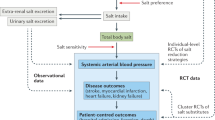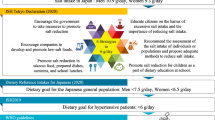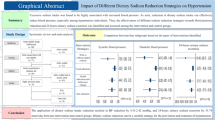Abstract
High dietary salt is a major contributor to increased blood pressure, the leading risk for death worldwide. In several countries, national programmes to reduce dietary salt have been implemented with leadership and involvement of hypertension experts. Other hypertension experts may be interested in assisting or leading a national programme to reduce dietary salt, however, may not have the experience or training to do so. The article is based on the experiences of three hypertension experts who have led the development of national dietary salt reduction programmes in the United Kingdom, Australia and Canada. The article advises developing leadership and a coalition, conducting a nation-specific environmental scan of facilitators and barriers, estimating the national health and financial costs of high dietary salt and the benefits of reducing salt intake, obtaining core documents to provide the scientific rational for the programme, developing a policy statement to outline the required actions to be undertaken, engaging government and industry, using media to gain public support, overcoming industry supported opposition and sustaining the effort long term. Resources and potential sources for international collaboration are provided as well as caveats for developing the programme within the specific nations’ context and overall effort to improve health. Developing and leading a national salt reduction programme is a major commitment, however, reducing dietary salt is estimated to be one of the most effective strategies to improve a nation's health.
This is a preview of subscription content, access via your institution
Access options
Subscribe to this journal
Receive 12 digital issues and online access to articles
$119.00 per year
only $9.92 per issue
Buy this article
- Purchase on Springer Link
- Instant access to full article PDF
Prices may be subject to local taxes which are calculated during checkout
Similar content being viewed by others
References
Eaton SB, Konner M . Paleolithic nutrition. A consideration of its nature and current implications. N Engl J Med 1985; 312 (5): 283–289.
Brown IJ, Tzoulaki I, Candeias V, Elliott P . Salt intakes around the world: implications for public health. Int J Epidemiol 2009; 38 (3): 791–813.
Panel on Dietary Reference Intakes for Electrolytes and Water, Standing Committee on the Scientific Evaluation of Dietary Reference Intakes. Dietary Reference Intakes for Water, Potassium, Sodium, Chloride and Sulfate. National Academies Press: Washington, DC, 2004.
He FJ, Marrero NM, MacGregor GA . Salt intake is related to soft drink consumption in children and adolescents: a link to obesity? Hypertension 2008; 51 (3): 629–634.
He FJ, MacGregor GA . A comprehensive review on salt and health and current experience of worldwide salt reduction programmes. J Hum Hypertens 2009; 23 (6): 363–384.
He FJ, MacGregor GA . Effect of modest salt reduction on blood pressure: a meta-analysis of randomized trials. Implications for public health. J Hum Hypertens 2002; 16 (11): 761–770.
He FJ, MacGregor GA . Importance of salt in determining blood pressure in children. Meta-analysis of Randomized Controlled Trials. Hypertension 2006; 48 (11): 861–869.
He FJ, MacGregor GA . Effect of longer-term modest salt reduction on blood pressure. The Cochrane Database of Syst Rev 2004; (3): 1–64.
World Health Organization. Global Health Risks; Morality and Burden of Disease Attributable to Selected Major Risks. World Health Organization Press: Geneva, Switzerland, 2009, pp 1–70.
Joffres M, Campbell NRC, Manns B, Tu K . Estimate of the benefits of a population-based reduction in dietary sodium additives on hypertension and its related health care costs in Canada. Can J Cardiol 2007; 23 (6): 437–443.
Departamento de Epidemiologia Ministerio de Salud. Chilean Health Report. Ministerio De Salud: Gobierno De Chile, 2003.
Danaei G, Ding EL, Mozaffarian D, Taylor B, Rehm J, Murray CJ et al. The preventable causes of death in the United States: comparative risk assessment of dietary, lifestyle, and metabolic risk factors. PLoS Med 2009; 6 (4): e1000058.
Asaria P, Chisholm D, Mathers C, Ezzati M, Beaglehole R . Chronic disease prevention: health effects and financial costs of strategies to reduce salt intake and control tobacco use. Lancet 2007; 370 (9604): 2044–2053.
Palar K, Sturm R . Potential societal savings from reduced sodium consumption in the U.S. adult population. Am J Health Promot 2009; 24 (1): 49–57.
Dall TM, Fulgoni III VL, Zhang Y, Reimers KJ, Packard PT, Astwood JD . Potential health benefits and medical cost savings from calorie, sodium, and saturated fat reductions in the American diet. Am J Health Promot 2009; 23 (6): 412–422.
Penner SB, Campbell NRC, Chockalingam A, Zarnke K, Van Vliet B . Dietary sodium and cardiovascular outcomes: a rational approach. Can J Cardiol 2007; 23 (7): 567–572.
Mohan S, Campbell NR, Willis K . Effective population-wide public health interventions to promote sodium reduction. Can Med Assoc J 2009; 181 (9): 605–609.
Murray CJ, Lauer JA, Hutubessy RC, Niessen L, Tomijima N, Rodgers A et al. Effectiveness and costs of interventions to lower systolic blood pressure and cholesterol: a global and regional analysis on reduction of cardiovascular-disease risk. Lancet 2003; 361 (9359): 717–725.
World Health Organization Nutrition and Food Security Programme. Food Based Dietary Guidelines in the WHO European Region. World Health Organization: Copenhagen, Denmark, 2003.
World Health Organization. Reducing Salt Intake in Populations: Report of a WHO Forum and Technical Meeting 5–7 October, 2006 Paris. World Health Organization; France, Geneva, Switzerland, 2007.
Lester H, Schmittdiel J, Selby J, Fireman B, Campbell S, Lee J et al. The impact of removing financial incentives from clinical quality indicators: longitudinal analysis of four Kaiser Permanente indicators. BMJ 2010; 340: c1898.
Sodium Working Group. Sodium Reduction Strategy for Canada. Health Canada: Ottawa Canada, 2010.
Webster J, Dunford E, Huxley R, Li N, Nowson CA, Neal B . The development of a national salt reduction strategy for Australia. Asia Pac J Clin Nutr 2009; 18 (3): 303–309.
Logan AG . Dietary sodium intake and its relation to human health: a summary of the evidence. J Am Coll Nutr 2006; 25 (3): 4F–169F.
Penz ED, Joffres MR, Campbell NR . Reducing dietary sodium and decreases in cardiovascular disease in Canada. Can J Cardiol 2008; 24 (6): 497–501.
Henny JE, Taylor CL, Boon CS . Strategies to Reduce Sodium Intake in the United States. The National Academies Press: Washington, DC, 2010.
Scientific Advisory Committee on Nutrition. Salt and Health. The Stationery Office: Norwich, UK, 2003.
Campbell N, Legowski B, Legetic B, Wilks R . PAHO/WHO Regional Expert Group Policy Statement—Preventing cardiovascular disease in the Americas by reducing dietary salt intake population-wide. CVD Prevention and Contol 2010; 4: 189–191.
Webster JL, Dunford EK, Neal BC . A systematic survey of the sodium contents of processed foods. Am J Clin Nutr 2010; 91: 413–420.
Webster J, Dunford E, Barzi F, Neal B . Nutrient content of products served by leading Australian fast food chains. Appetite 2010; 55: 1–6.
Geleijnse JM, Kok FJ, Grobbee DE . Impact of dietary and lifestyle factors on the prevalence of hypertension in Western populations. Eur J Public Health 2004; 14 (3): 235–239.
Serneri GGN, Coccheri S, Marubini E, Violi F . Picotamide, a combined inhibitor of thromboxane A2 synthase and receptor, reduces 2-year mortality in diabetics with peripheral arterial disease: the DAVID study. Eur Heart J 2004; 25 (20): 1845–1852.
Kearney PM, Whelton M, Reynolds K, Muntner P, Whelton PK, He J . Global burden of hypertension: analysis of worldwide data. The Lancet 2005; 365 (9455): 217–223.
Author information
Authors and Affiliations
Corresponding author
Ethics declarations
Competing interests
Dr Bruce Neal has in the past 5 years been a Consultant/Advisor or received fees for attending a meeting from Pfizer (2005), Roche (2009), Takeda (2010), Pepsico (2010); Lecture fees (honoraria), travel fees or reimbursements when speaking at the invitation of a commercial entity—Amgen (2007), AstraZeneca (2010), GlaxoSmithKline (2007), Pfizer (2007), Roche (2005), Sanofi Aventis (2006), Servier (2008), Tanabe (2007); Research support from a commercial entity—Johnson and Johnson (2011), Merck Schering Plough (2011), Roche (2011), Servier (2010), United Healthcare Group (2011). Dr Neal interacts regularly with multiple large corporations in the Pharmaceutical Industry, the Food Processing Industry and the Quick Service Restaurant industry in Australia and overseas, in his efforts to achieve negotiated solutions to major public health problems. Dr Campbell has received travel support and a speaker fee from Boehringer Ingelhiem in 2010 but has no other conflicts of interest in the past 2 years, and Dr MacGregor has no conflicts of interest.
Rights and permissions
About this article
Cite this article
Campbell, N., Neal, B. & MacGregor, G. Interested in developing a national programme to reduce dietary salt?. J Hum Hypertens 25, 705–710 (2011). https://doi.org/10.1038/jhh.2011.25
Received:
Revised:
Accepted:
Published:
Issue Date:
DOI: https://doi.org/10.1038/jhh.2011.25
Keywords
This article is cited by
-
Relationship between urinary sodium with blood pressure and hypertension among a Kazakh community population in Xinjiang, China
Journal of Human Hypertension (2017)



